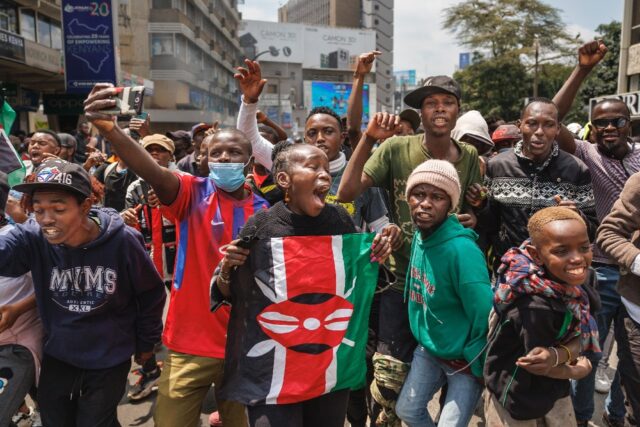Hundreds of protesters took to the streets across Kenya on Tuesday in defiance of a police ban, the latest in a series of anti-government demonstrations that have rocked the East African nation.
In the capital Nairobi, shops and offices were shut as some protesters mobilised to march to the main Jomo Kenyatta International Airport (JKIA), one of the busiest in Africa.
Police had warned against the march, saying trespassing on protected areas, including airports, would risk prosecution.
Activists led by young Gen-Z Kenyans launched peaceful rallies last month over steep tax increases that spiralled into deadly violence, before morphing into wider anger against President William Ruto’s government.
While Ruto has taken a series of measures to try to end the worst crisis of his near two-year presidency, including dropping the tax hikes, activists have vowed to pursue their protest action.
On Tuesday, heavily-armed police were deployed on the roads leading to the airport, while aviation authorities told passengers to arrive hours before their flights to navigate the increased security checks.
“There is no doubt that the current demonstrations have become a haven for goons, motivated and opportunistic offenders to loot and destroy property,” acting national police chief Douglas Kanja told reporters.
“We wish to reiterate that any person who breaks the law will be dealt with swiftly, firmly and decisively.”
The army was deployed to an estate in Embakasi, a densely populated district bordering the airport, where protesters had blocked the road using stones.
Protesters had sought to occupy the airport in response to reports that the government was planning to enter a deal to lease JKIA to an Indian firm, a move the government has denied.
At least five protesters had been arrested elsewhere on a road some 15 kilometres (9 miles) from the airport, a police source told AFP.
“Officers have shown a lot of restraint today,” she said.
In the coastal city of Mombasa, police fired tear gas at dozens of protesters who had gathered in the city centre, according to images broadcast on local media.
Elsewhere in the country, television broadcast images of people lighting bonfires in the western town of Migori and central Karatina.
‘Enough is enough’
Tuesday’s demonstrations came as the lower house of parliament resumed with a debate on the finance bill containing the tax increases that was scrapped by Ruto last month.
Parliament precincts have been the epicentre of many of the marches and the scene of violent and sometimes deadly chaos, particularly on June 25 when protesters stormed and torched a section of the building and police fired live bullets at demonstrators.
At least 50 people have been killed and more than 400 wounded since the start of the protests on June 18, according to the state-funded Kenya National Commission on Human Rights.
Rights groups have accused police of using disproportionate force against the protesters.
Scrambling to contain the fallout, Ruto has embarked on a series of measures including government cuts and dismissing almost his entire cabinet.
The embattled leader named a partial new cabinet lineup last week but it includes several ministers who had initially been dismissed, infuriating many protesters.
Ruto, who has said he plans extensive consultations across different sectors and political groupings, struck a stern tone on Sunday and vowed to put paid to the protests.
“I want to promise it is going to stop. Enough is enough,” he said.
Kenya has been struggling with a cost of living crisis and weakening currency, with Ruto’s administration pushing for higher taxes to increase revenues in a bid to reduce foreign debt standing at $78 billion, according to treasury records.
Corruption and state extravagance also remain entrenched.

COMMENTS
Please let us know if you're having issues with commenting.